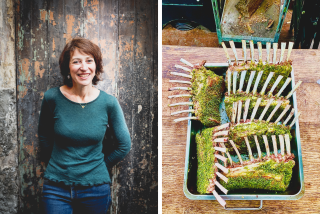Herb Your Enthusiasm
When it came to herbs, I’d always thought California was no shabby show. Since the 18th century, Spaniards, Mexicans, Italians, French and Asians have brought in everything from basil, parsley and coriander to rosemary, wild fennel, verbena, sage and thyme, adding variety to the indigenous bay laurels. But my first trip to Provence uncovered an open-air potpourri unlike anything I had experienced before.
A riot of perfumed edibles stretches south from Vaison-la-Romaine to Marseilles on the Mediterranean, the hills and dales made famous by Cezanne and cloaked with the celebrated quartet of fragrant wild plants that constitutes herbes de Provence: rosemary, thyme, oregano and sarriette (or savory, a kind of wild mint).
In America, we tend to think of herbes de Provence as something dry and comfortingly French that you shake from a jar into bubbling sauces. But the denizens of this vast Midi region prefer their herbs fresh and powerful to the tongue and nose. I once wound up on cortisone in an Avignon hospital, unable to breathe, after lunching at one-star Prieure in what must be the world’s most overwhelmingly floral, allergen-permeated restaurant garden, where the 30-foot festoons of blossoming wisteria were drowned out by an A-to-Z of other scents, including the masses of fresh thyme flowers on my plate.
You’d think the wild or range-raised animals that feed on this herbal bounty wouldn’t need further seasoning. But as I’ve learned on many repeat visits, antihistamines in hand, local cooks find herbless cuisine inconceivable. At a family-style eatery in Vacqueyras, a walled wine-making town famed for its impossible name, the wild hare I savored had been marinated in the local red wine spiked with the ubiquitous herb quartet plus garlic, onion, black pepper and bay.
East of Aix-en-Provence, in the angular shadows of the Montagne Sainte-Victoire--Cezanne’s prime painterly obsession--the lambs whose fleece and flesh are already redolent of wild thyme wind up coated in more herbs and barbecued over coals sprinkled with a heady herbal potpourri. More surprisingly, as I experienced at Relais Sainte-Victoire in the village of Beaurecueil on the mountain’s flanks, the herb-fed lamb comes slathered with herbed-honey made by herb-fueled bees, and is showered with more fresh herbs or shredded lavender. You can eat lavender? Talk about purple majesty: the Provencaux not only distill or dry the stuff, they also savor it, sprinkling it over a maddening variety of foods as a garnish.
The historical reasons underpinning the massive use of herbs in Provence can be summed up in three words: cheap, abundant and effective. As I learned from a craggy park ranger posted on Cezanne’s beloved mountain, much of the wind-worn, blasted beauty of Provencal places such as the Montagne Sainte-Victoire is the result of ancient depredation. Lavender, thyme, rosemary and oregano, hemmed by rockrose, were the flora that could cling to slopes eroded after Roman legionnaires or medieval monks deforested them to plant olive groves or create grasslands for grazing. An ambiguous heritage perhaps, but one that’s inspired great artists, delighted millions of Provence pilgrims and put some of what I consider France’s most flavorful foods on the table.
Chicken Marinated in Herbes de Provence
(Adapted from “Les Herbes de Provence,” by Sylvie Ligny)
Serves 6-8
2 cups dry French white wine
2 tablespoons fresh thyme
2 tablespoons savory
2 tablespoons oregano
2 bay leaves
2 cloves
11/2 teaspoons coarse sea salt or kosher salt
1 tablespoon freshly ground black pepper
2 shallots, peeled and chopped
6 cloves garlic, peeled and chopped
1 5-pound chicken, cut into parts
4 tablespoons extra-virgin olive oil
Pour wine into ceramic bowl. Add herbs and spices, whole. Stir shallots and 2/3 of garlic into marinade. Add salt and pepper. Rinse chicken under cold water, pat dry with towel and cut into parts. Put chicken parts into marinade, coat and submerge. Cover bowl with plastic wrap and refrigerate for at least 12 hours. Remove chicken, pat dry and lay on platter. Pour oil into large skillet and heat over medium heat. Add remaining garlic and saute for 30-60 seconds, until barely colored. Add chicken pieces and brown thoroughly, stirring, flipping and scraping with wooden spoon, 8-10 minutes. Filter marinade through sieve while pouring it into medium-sized bowl. With ladle, add about 1 cup of marinade to skillet, bring to boil and lower heat to medium-low. Simmer semi-covered for 30-35 minutes, adding marinade half a ladle at a time, and stirring occasionally. Remove skillet from heat. Transfer chicken to serving platter. Pour half of pan juices into sauce boat and the other half over chicken. Serve hot.
More to Read
Eat your way across L.A.
Get our weekly Tasting Notes newsletter for reviews, news and more.
You may occasionally receive promotional content from the Los Angeles Times.










